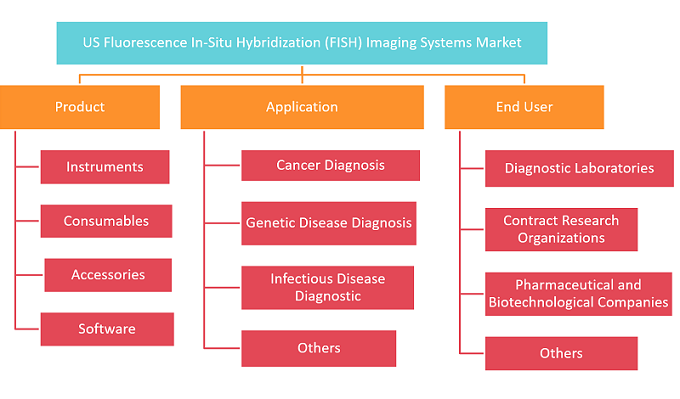Consumables Segment, by Product, to Dominate Fluorescence In-Situ Hybridization (FISH) Imaging Systems During 2022–2030
According to our new research study on "US Fluorescence In-Situ Hybridization (FISH) Imaging Systems Market Size and Forecast (2020–2030), Country Share, Trends, and Growth Opportunity Analysis," the market is expected to grow from US$ 419.74 million in 2022 and is expected to reach a value of US$ 733.71 million by 2030; it is anticipated to record a CAGR of 7.2% from 2022 to 2030. Key factors driving the fluorescence in-situ hybridization (FISH) imaging systems market growth are rising prevalence of target disorders and increasing R&D investments in in-vitro diagnostics. However, the high cost of FISH imaging systems and procedures hinders the market growth.
FISH imaging systems are witnessing a remarkable evolution due to the surge in technological advancements, which result in cutting-edge innovations transforming the landscape of genetic research and diagnostics. These advancements include enhanced optics, more sensitive and versatile fluorophores, and sophisticated automation features. Modern FISH imaging systems, integrated with these upgraded features, offer greater sensitivity, improved image resolution, and faster processing times. Moreover, these technological advancements have extended the application scope of FISH imaging from cancer diagnosis to genetic predisposition testing. In July 2021, BioView and Capio Biosciences collaborated to create a platform for collecting circulating tumor cells (CTCs) from whole blood. These companies further improved the CTC liquid biopsy downstream analysis by integrating their technologies. Similarly, in collaboration, BioView and Capio Biosciences partnered with RUBYnanomed in December 2020 to create a unique imaging solution to accelerate the acceptance and adoption of CTC technology in clinics to enhance cancer detection. Thus, technological advancements in FISH imaging systems create significant opportunities for companies in the fluorescence in-situ hybridization (FISH) imaging systems market.

US Fluorescence In-Situ Hybridization (FISH) Imaging Systems Market 2030
Download Free SampleUS Fluorescence In-Situ Hybridization (FISH) Imaging Systems Market Size and Forecasts (2020 - 2030), Regional Share, Trends, and Growth Opportunity Analysis Report Coverage: By Product (Instruments, Consumables, Accessories, and Software), Application (Cancer Diagnosis, Genetic Disease Diagnosis, Infectious Disease Diagnostic, and Others), and End User (Diagnostic Laboratories, Contract Research Organizations, Pharmaceutical and Biotechnological Companies, and Others)
Euroclone SpA, TissueGnostics GmbH, Agilent Technologies Inc, Abnova Taiwan Corp, BioGenex Laboratories Inc, Leica Biosystems Nussloch GmbH, MetaSystems Probes GmbH, Bio-View Ltd, Thermo Fisher Scientific Inc, Applied Spectral Imaging, and PerkinElmer Inc are among the key companies operating in the fluorescence in-situ hybridization (FISH) imaging systems market. The companies have been implementing various strategies that contributed to their growth and led to various changes in the market. The companies have utilized both organic strategies (such as launches, expansion, and product approvals) and inorganic strategies (such as product launches, partnerships, and collaborations).
For instance, in June 2023, Agilent Technologies Inc had released the enhanced xCELLigence RTCA Software Pro Version 2.8, an integrated software package for running and analyzing real-time cell analysis data. This improved version enabled Agilent xCELLigence Real-Time Cell Analysis systems in GMP-regulated facilities.
The report segments the fluorescence in-situ hybridization (FISH) imaging systems market as follows:
The fluorescence in-situ hybridization (FISH) imaging systems market, by product, is segmented into instruments, consumables, accessories, and software. The consumables segment held the largest market share in 2022 and is anticipated to register the highest CAGR during 2022–2030. Consumables are the most promising segment of the fluorescence in-situ hybridization (FISH) imaging system market that will contribute to tremendous growth in the coming years. FISH consumables include hybridization buffers, probes, tag detection kits, signal amplification detection kits, and others. The presence of manufacturers such as Abbott, F. Abnova, and Thermo Fisher Scientific bolsters the market for the consumables segment. These products are frequently used in various research diagnosis processes, which is expected to propel consumption. Thus, the presence of various market players offering probes & kits and technological advancements by market players are likely to propel the market for the segment in the coming years. Based on application, the fluorescence in-situ hybridization (FISH) imaging systems market is segmented into cancer diagnosis, genetic disease diagnosis, infectious disease diagnosis, and others. The cancer diagnosis segment held the largest market share in 2022 and is anticipated to register the highest CAGR during 2022–2030. Based on end user, the fluorescence in-situ hybridization (FISH) imaging systems market is segmented into diagnostic laboratories, contract research organization, pharmaceutical and biotechnological companies, and others. The diagnostic laboratories segment held the largest market share in 2022 and is anticipated to register the highest CAGR during 2022–2030.
Contact Us
Phone: +1-646-491-9876
Email Id: sales@theinsightpartners.com